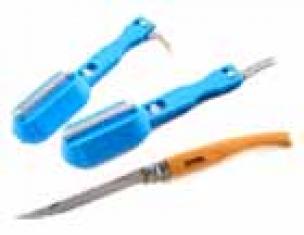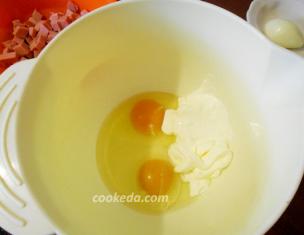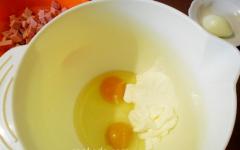How useful the fish is, and how much delicious it can be made from! But ... Probably not to find a woman who would not wrinkle her nose at the very thought of these torments. They say that it should be cleaned, which means that the whole kitchen is again in the scales, hands are cut up, scratched, and smells will haunt for several days.
Want to make cooking a joy? Let's learn to properly prepare this product. After all, fresh fish is not cooked everywhere. And to buy fillets is not always desirable - who knows how much the carcass has lain before in the freezer and how many times it has been thawed. So, I offer several options for cleaning fish.
What is necessary to clean the fish?

Tools for cleaning fish
- Sharp knife . If this is your first time doing this, do it with a blunt side and or take a blunt knife. After all, large scales can be removed even with a fork. If you have a scraper adapted for this purpose, or a grater, then in the case of small scales this will be wonderful.
TIP: Make grater yourself. Previously, bottle caps rescued - nailed a few to the plank, and wield. Now you can take an empty can, cut into its ends, and nail it to the bottom with a bottom.
- Paper towel.
- Cutting board.
- Kitchen scissors.
- Rinsing water for hands.
Preparation of fresh fish for cutting - step by step instructions with photos
The first thing to do is rinse the fish under the pressure of water. This is especially true for large specimens (like mine - weighing 2 kg).
After washing off the dirt from the carcass, removing the mucus with a napkin, look into the mouth of the fish bought on the market — whether the bait was left in the form of cornfish or something else.
TIP: Cook fish without a head? Do not cut it off! Indeed, in the process of cleaning you will have to hold on to it, otherwise a slippery carcass will strive to slip onto the floor.
And now - the main options and stages!
Option number 1

Step 1. Prepare the carp carcass
Why clean the fish! What a question? Of course, in order to cook and eat comfortably a dish. But, by the way, sometimes the scales are not removed at all. After all, she sometimes can enhance the taste of the dish. It also retains nutrients. You guessed it? But I'm not just about ear. After all, this is what they do when steaming or stewing. Dishes are aromatic and rich.
In this situation, cleaning is limited to gutting and filtering broth, if it is an ear.
TIP: The fish at the same time should only be fresh, but not thawed!
Option 2
Put the clean carcass on a chopping board. So that you do not get injured even from a tiny fin, arm with scissors. It is urgent to cut off anything that could cause injury. You can do it with a knife and make cuts. But I love scissors - so the fish is more whole.

Step 2. Cut the fins
What scales does a fish have? What size is it? If you get a small copy, take the carcass in your free hand, pry the scales with a knife at the tail and, pressing the blade almost flat, start the movements of the knife towards the head. If the fish is large, like me, hold it on a cutting board, grabbing the gills. Clean with a sharp movement, moving with a knife or float against the growth of scales from tail to head. Gently, because your left hand is very close!

Step 3. Remove the scales
Running your hand over the surface, did you find that there was not a single scale left? It's time to start cutting the abdominal cavity. But before that, thoroughly wash the fish so that the scales do not get inside the board. Carcass lies on the board. With your free hand (you can wrap it with a paper towel or something else) make a cut along the abdomen with a knife or scissors.
BTW: Do not cling to the fish too much with a knife, otherwise its surface will be damaged or the abdominal cavity will open, which is undesirable.

Step 4. Making a cut
Choose everything inside. To do this, move your hand deep into. If you feel that she has rested against the walls, start slowly putting your fingers under the insides. Catch them and move them, slightly tearing, to the very head. Very neat - here is the gallbladder. Do not forget to rinse the abdomen well!
TIP: Violation of the integrity of the gallbladder? Do not be discouraged, just urgently rub the salt in the place where the bile touches the fish. You can cut with a knife, but immediately and carefully, without damaging the integrity!

Step 5. Vypotroshim fish
Then it all depends on what you cook. That is, use it entirely or without a head and tail, for example, you need a fillet or a carcass. In the second case, we place the fish on the board and, holding its head with the second hand, cut it off smoothly and quickly.
ATTENTION: During a careful cleansing of the viscera, it is advisable to go deep under the head with your index finger - there are always blood clots that will spoil the taste of the dish. Especially if you want to trim your ear! Rinse with water several times. Grab a knife on both sides and fins - there is a good piece of meat grabs.

Step 6. Cut off the head with a fin

Step 7. Cut off the tail
Do you want to cook soup, as the fish is large? Then cut off all the pieces so that there is more meat in them (in the area of both the head, the tail section, and the fins). Do not forget to remove the gills from the head and eyes. Here is a beautiful cut turned out!

Step 8. Headless carcass
You have a task to chop steaks? If the fish is small, there will be no problems. But with a large need to tinker, because the pieces should be beautiful and smooth. You can incise with a sharp knife to the ridge, and then cut with a cleaver.

Step 9. Steak
But you need to separate the fillets? What kind of pieces or the whole carcass to use? Let's start. The process is not easy, but real. Use a sharp knife to hold the knife along the entire length of the ridge. Reached the pits? Now gently lead the knife to the bottom, hooking the meat. It will turn out two. If you already have steaks, do the same, separating the meat from the ridge.

Step 10. Separate the fillet.
Then do what the next scenario requires. That is, it will be either two fillets, or you will cut them into slices. The main thing - get rid of all the bones, do not throw away any fin and ridge! I want to brag - that's how I got such a wonderful soup kit. Somehow lay out the soup recipe that came out of it!

Step 11. Fish soup set
Option number 3
It's all easier in terms of removing scales. Dipping the carcass for a few seconds in boiling water, you can easily get rid of it.
With a sharp knife, make two cuts across the head and closer to the tail. Spice up the belly and gut the carcass.
Cut the upper fin by two longitudinal cuts side by side, and pull out the lower fin.
Remove the gills and eyes from the head. Slice the steaks or fillets and cook!
A few helpful tips on how to prepare fresh fish for cooking.
- To avoid smells. Smear the board, knife and hands with lemon. Finally, wrap the board in polyethylene and immediately collect the scales and insides in the bag.
- To the fish did not slip out. You can either rub your hands with salt or wrap them in a towel or napkin.
- To scale not scattered. Open the tap and continue to clean the fish under the tap. Wrap the carcass in polyethylene, collecting the insides and scales. Or spend the whole procedure in a deep bowl or a bucket of water - so the scales will not be on the walls and floor
- If scales dried out. Rinse the carcass again, or hold it a little in icy water (but not warm!).
- If the scales are stiff or tightly pressed to the skin. Rinse the carcass with boiling water.
- It is better to clean the fish immediately after purchase.
- Slightly oxidizing the water with vinegar or lemon, hold the fish in it - it will become easier to clean!
- Do not forget to remove the film inside - brown can make her taste bitter
- Take only sharp knives, but put a brilliant green nearby - suddenly cut!
- Put the fish in the fridge, wrapping it in a damp cloth or polyethylene - so it will not wither.
- Pack with guts should immediately tie and immediately make.
- Cutting fish is best done on a special board.
And know - careless cleaning of fish will accurately affect the taste of the dish. Because not lazy!
Many novice housewives sooner or later wonder how to clean the fish before cooking it in a frying pan, in the oven or in another way.
If you follow the simple recommendations on how to clean the fish and carve it properly, then you can be sure that this occupation is not as laborious and unpleasant as it seems at first glance. Do not forget that before you clean the fish, you need to rub it with coarse salt, this will greatly facilitate the process. Such a simple technique will help avoid slipping out of your hands during cleaning.
1. Cleaning scales. In most cases, cutting fish begins with the need to clean the scales. In this case, it is desirable to place the fish in a container with cold water, and place the hands above the water. This will prevent the scales from scattering around the table. Someone puts the fish in a bag of cellophane and cleans it of the scales already in it. If you are left-handed, it will be convenient to clean the fish, putting its tail on the left, and if right-handed, then vice versa. You can start cleaning the husk. It is necessary to slightly tilt the knife and remove the scales, starting from the tail to the head, that is, as if against the coat. Husks must be removed on both sides. If it is very difficult to clean, we lower the fish for 2 minutes in hot water. If the fish will be cooked with the head, remember that the gills need to be cut.

2. Eviscerate. Wash the fish in cold water and begin gutting. A thin, sharp knife should be made on the fish belly from the head to the anal fin with a longitudinal incision. We remove all the entrails, as well as trying to remove the film lining the abdomen. When taking out the viscera, you must be careful with the gallbladder, so as not to damage it. Rinse the fish again in cool water. Now it can already be baked, fried or steamed, whole.
3. Cutting into pieces. Washed fish should be cut into pieces, starting from the head. First you need to cut the meat of the upper part to the bone, then with a slight blow of the knife you need to cut the bone of the spine and cut the meat of the lower half. Remove the tail, head and fins. The resulting pieces can already be cooked.
4. Fillet. If you need to prepare fillets, we cut the fish along the spine along the back, so that the spine and rib bones are on one layer, and the rib bones are on the second. Remove the bones and cut the layer into portions across. Already clean fillets should be rinsed well with cool water. If you want to cook a fish roll or cutlets, remove the skin from the fillet.

If the fish will not be prepared immediately, it is not necessary to cut it into fillets or pieces immediately after washing and gutting. So it will last longer.
Depending on the specific type, you need to choose the best method for cleaning the fish. Before you start cleaning, live fish must be stabbed. This can be done with the sharp end of a small kitchen knife. We cut through his throat between the fins of the head and wait for the blood to drain.

Clean the naga. Cut the skin of the fish along the back. Cut off the lower jaw, and remove the skin from both sides, you need to start with the upper jaw in the direction of the tail. Then we remove the fins and remove all the insides, but we do not cut the abdomen. Leave the spawn inside. Then the navaga need to be washed in cold water.
We clean catfish, burbot, eel. We cut the skin around the head and remove it from the whole fish completely, like a glove from a hand. After that, we cut off the head, cut the abdomen and get rid of the entrails. Wash the fish in cool water.
Clean line. You need to put the fish for half a minute in hot water and wait until the slime comes down, the scales will be removed much easier. After that, you need to shift it in cool water and remove the scales with the blunt side of the knife. Gut and wash the fish.
This article is protected by copyright and related rights. At full or partial reprint of the material, an open link for indexing the active link to is required.
Fish deserves one of the main places on our table. Nevertheless, many hostesses prefer not to butcher this product, but rather to buy already packaged in a store. After all, there is a perception that it is difficult to clean and cut river and seafood products because of the mucus that covers the carcass and the scales flying in all directions. In fact, cleaning and preparing fish for thermal treatment of fish does not constitute labor; the main thing is to know how to do it correctly.
What you need for cleaning and cutting fish
Many of us prefer to clean and carve the carcass with an ordinary kitchen knife. But there are plenty of cleaning methods that may require other tools:
- sharp knife;
- scaler;
- grater;
- chopsticks;
- fork;
- tablespoon;
- fishing knife;
- high pressure hose or körcher;
- tin;
- drill;
- rubber gloves;
- kitchen scissors.
A sharp kitchen knife is not the only device that can clean a fish
How to clean the fish
Of course, the cleaning of river and sea fish differ. Mostly because of the size of the scales. Marine cleaned easier and faster, as it is covered with small scales, which quickly disappear during physical exposure. However, there are some rules that you should know to make your job easier.
How to clear mucus
Some types of fish, before removing them from the scales, you need to clear the layer of mucus. There are several ways to solve this problem:
- We lower the carcass for 15–20 seconds in very hot water. The mucus will come off during this time, and you can start cleaning.
- The second method is also quite simple. Before cleaning the product is rubbed with salt. The carcass ceases to slip in the hands.
- On fishing instead of salt, you can use the sand. But this method is not very convenient, because it is good to wash the sand grains from the meat later.
- On 3 l. water diluted 1 tbsp. l table vinegar. Put the carcasses into the solution for 1-2 minutes. Mucus is easily removed.
It's time to catch eels. They caught it and brought it home. The fish is interesting, but how to clean it from mucus. They brought the fish, put it in a bowl or any other dish, and sprinkled the fish in large quantities with coarse salt. They were allowed to stand for 20 minutes. Salt corrodes mucus. It remains a little rub the remaining salt and rinse with water.
Wladimir
I make it even simpler. Straight on fishing to roll a fish in dry sand, with one hand tightly hugged around the neck, with the other you take over the head and stretch it. And so several times, it cleans nicely.
Neighbour
http://www.rybolov.de/poleznye_sowety/aal
And still get rid of mucus, and not only on acne, but also in other fish, you can use vinegar.
http://www.rybolov.de/poleznye_sowety/aal
Proper Scale Cleaning
Before you start cleaning, fill the sink, basin or any other container with water. Lower the carcass into the water. This will avoid unnecessary cleaning: the scales will not scatter in the kitchen, but will settle in the liquid.
Instead of a fish scaler, you can use a fishing knife, a kitchen sharp knife, a tablespoon, or a fork. This method is perfect for various types: river and sea. However, with larger individuals will have to put more effort.
How to clean the fish
Clean fast
One of the most effective and fastest ways to clean fish from scales is cleaning with the help of a grater. For this method, we use a grinder with 4 ribs, it is more convenient to use.

In nature, instead of a float, you can use a tin can by piercing the bottom with nails. In this way, pink salmon, chum salmon, perch and other species are cleaned. For individuals with tough scales, you can use a coarse fillet.

Instead of a grater, you can use a tin can pierced with nails.
How to quickly clean the fish with a grater
How to do it with ... drills
Folk methods are often unusual, but nonetheless effective. We will tell how to carry out cleaning with the help of a conventional drill:

Drills remove scales from river and sea individuals. She perfectly copes with both small and large hard scales.
Cleaning Video Tips
Cleaning with KARCHER
This method of cleansing fish from scales is convenient in nature, in the country or in the yard of a private house:

This method is convenient for cleaning large individuals. Small fish will not be able to withstand the pressure of water and will fall from the lock.
Scale Scaler Cleaning
How to clean frozen
Many experts advise to defrost the fish before removing the scales from it. But the time to defrost more often is not enough. Can I clean the carcass that just got out of the freezer? It is possible, because frozen products are quite easily cleaned of scales.

The method is perfect for small fish weighing up to 1.5 kg. Carcasses weighing more than 1.5 kg are best defrosted, so as not to get hurt during cleaning and cutting. This method is used when removing scales in river species: crucians, perches, bream, and others, as well as in marine fishes, including salmon.
Frozen Fish Processing Processing Videos
Evenki cleansing method
In the north, this method is used constantly, it is convenient and easy to use:

The method is interesting because even when cleaning fish with small scales, only scales are cut off, not skin. She remains untouched. In this way, in the north, all species that have been frozen are cleaned.
Evenki fish scale cleaning
How to carve the carcass
After scaling off the fish, it is necessary to cut the fish in order to proceed to the preparation stage.
How to gut Chinese chopsticks
This method of gutting fish is used in the case when it is necessary to keep the whole carcass.

How to gut fish in the Chinese way
How to cut fish in different ways
Fish can be chopped in different ways. It depends on how we are going to prepare them.
How to quickly cut into fillets
To quickly and efficiently carry out the cutting of the fillet, we need a sharp knife.

This method is also called "Finnish". For cutting it is more convenient to use a knife with a long blade.
For portions- "round"

For stuffing
Basically, the fish is stuffed or in chunks or whole.
Another way to cut fish

For stuffing
- We split the fish as well as fillets.
- Medium-sized bones are removed with tweezers.
- Scroll the meat through a manual meat grinder 2–3 times.
- Stew minced for 1-2 minutes until complete softening of the smallest bones that could get into the stuffing.
- Stuffing ready.
When using this method, a manual Soviet meat grinder is indicated. Other household appliances can be used: a combine harvester, a blender, or an electric meat grinder. But the combine or electric analogue of the meat grinder does not grind the fish bones so small, there is a great risk of injury after eating minced meat.
I often do carp cutlets. I buy a whole silver carp, rip off the skin along with the scales, it is like a stocking. From the ridge I cut the meat, it turns out two fillets without large bones. I grind in a Soviet meat grinder, the bones remain all in the meat grinder, and then I make delicious meatballs out of minced meat.
AntiTrol
I made mince in a combine, it turned out to be air, but I don’t grind a combine harvester, once I tried it.
Anna
http://sovet.kidstaff.com.ua/question-678004
Features of cleaning and cutting fish
- When cleaning and cutting salmon: salmon, pink salmon, chum salmon, salmon, and others, you can not clean the scales, and cut the fillets from the skin.
- Small size perches can be cleaned from the scales with your fingers. It is enough to boil the carcass with boiling water and remove the scales.
- It is better not to scrape the scales from the flounder. We remove the skin in the direction from the tail to the head along with the scales. To do this, at the base of the tail, make a small incision and hook the skin.
- When cleaning and cutting carp, it is very easy to get rid of small bones. We make frequent cross-cuts. When preparing the small bones soften under the influence of high temperature.
- Small bones from herring, trout, rudd, omul are removed with tweezers.
- Small fish, for example, capelin or sprat are prepared entirely. If we still fear that the bones will fall in the ear, you can cook it in a gauze bag.
- When stuffing from the head of the carcass, the eyes and gills are necessarily removed.
- If the gallbladder broke during gutting, wipe the place on which the bile came in with salt.
- For making minced meat it is better to choose large fish: salmon, catfish, pike perch.
As we see, quickly cleaned and cut the fish into fillets, minced meat or portions of the pieces is a snap. Fish retains its structure and taste in any method of cleaning and cutting. Now you can be sure that fish dishes will please not only amazing taste, but beautiful appearance.
For many, the process of cleaning fish is associated with a boring and monotonous occupation, the finale of which is picking up fish scales that have spread throughout the kitchen.
Tool
 The traditional tool used for cleaning fish is.
The traditional tool used for cleaning fish is.
Those who do not have to clean the fish and those who have not yet gained the necessary experience of using the knife to separate the scales, it is recommended to clean the fish with the blunt side of the knife.
To avoid injury, you can clean the fish with a spoon or fork.
There is also a special tool similar to a scraper. It is easy and safe to work.
To clean fish with hard scales (ruff, perch, etc.), use a special grater. It can be made independently by nailing several tin corks from the beer to a wooden plate.
A good grater will serve and an empty tin can, in the bottom of which holes are punched with a large nail so that sharp jags form on them.
Preparatory work
 First of all, rinse the fish under cool running water. If after washing the fish some time has passed, during which the scales managed to dry, wet the fish again with cold water - so the process of getting rid of the scales will go much faster.
First of all, rinse the fish under cool running water. If after washing the fish some time has passed, during which the scales managed to dry, wet the fish again with cold water - so the process of getting rid of the scales will go much faster.
In case fish scales are very tough or tight to the skin, dip fish carcass for a few seconds before cleaning. The main thing is not to overdo it.
To avoid injury from sharp fish fins during cleaning, cut them with kitchen scissors or cut them with a thin, sharp knife.
Cleaning fish
 The main question that every fish who cleaned himself inevitably asked himself was, at least once in his life: “How can I make the fish scales not scatter in all directions during the cleaning process?”
The main question that every fish who cleaned himself inevitably asked himself was, at least once in his life: “How can I make the fish scales not scatter in all directions during the cleaning process?”
There is nothing easier - many people clean the fish immersed in a container with water. With this approach, a very rare scale will be able to overcome the resistance of the water layer and fly out from under the knife.
Another solution to the problem is to place the fish carcass in a spacious, durable and transparent plastic bag, performing all the cleaning procedures without removing it from the bag. In this case, absolutely all scales will remain in the package, without creating additional trouble for cleaning the kitchen at the end of the work.
If the spreading scales are not a problem for you, feel free to lay out the fish on the kitchen board. Fix the fish, pin its tail to the wooden board with an awl or any other sharp object.
If, after this, the fish is pulled out, holding its fingers behind the head, it will not be difficult to clean it of scales.
Actually the procedure of cleaning fish is simple and hardly needs a detailed description. Having placed the fish head to yourself, start getting rid of the scales from the tail, working as a tool against the growth of scales, gradually moving towards the head of the fish.
To make life easier for all housewives, we will talk about how to clean the fish properly. In fact, there is nothing incredibly complicated in this process, but you realize this only when you see a plate of cleaned, gutted fish. And when in your hands for the first time it turns out to be a big, live carp, you look at it in incomprehension.
If you have a live fish in your hands, you must first “neutralize” it and then clean it. To do this, you can turn to the one who caught her and hit him on the head with something (not a fisherman, but a carp). For some housewives, this process is the most difficult, therefore, in order not to complicate your life, you can put the catch under the freezer - you will get a freshly-cooled fish, which also peacefully waits to be cleaned.
If you buy fish on the market, it is important to choose fresh - it is not slippery, without unpleasant color and smell, and the meat keeps tight, not separating from the bones.
The very first stage of cleaning is washing the carcass under running cool water. Now you can begin to clean the fish and it’s good if you have a special knife for this (it is cheap and is sold at the market or in fishing stores). Special fish scalers that look like scrapers are very popular.
But if there is no such tool, the usual one will do, but you have to be careful with it and clean it with the blunt side so as not to cut yourself. Some hostesses in order to avoid injuries, clean any convenient object - a spoon, fork, etc. Cleaning is best done in the same sink where you washed the fish. Be prepared for the scale to fly in all directions. Therefore, many housewives put the fish in the bag and clean it as if in a bag, and put on a plastic or metal net in place of the sink in the sink. Here every housewife has his own recipe. Someone puts a large bowl in the sink and does everything in it to keep all the scales there.
The fish must be properly held: the head must look at you, and you hold it by the tail and brush it from the tail, slowly heading towards the head, the scales fly away at this time. Once you have completed the task, rinse the fish again under running water.

Tip: If you choose a fish to which the scales are very tight, lower it for two seconds into boiling water.
How to gut fish
For gutting you need a kitchen knife and a cutting board. If the board is wooden, the smell will not be washed off at a time, therefore we recommend covering the board with a newspaper or a regular bag. This technique will allow you to get rid of the smell of fish immediately after the end of the evisceration of the carcass and quickly remove the work area. By the way, this advice is also relevant for plastic boards.
We lay the carcass on the board with the ridge down and belly up. Using a kitchen knife or scissors, we cut the belly almost from the head to the anus (located near the tail), so that it is convenient to get “all the contents” and clean it with a knife, while trying not to hurt the gall bladder. Do not forget, in addition to the guts, to remove the red-brown film on the walls of the belly.

Go to the head. If you decide to leave it, you need to remove the gills so that the future dish does not taste bitter. If the head is too small or simply not needed - cut it off and do not suffer. After this, once again wash the fish thoroughly and you can begin to create a delicious meal.
As you can see, the process is not complicated, but after it you will be overwhelmed with a sense of pride that you could manage on your own. By doing this at least once from beginning to end, you can tell your friends how to clean fish from scales.
If you still do not know to cook this, look at the recipes on our website. You can, for example, cook fish in batter or, if you cleaned crucian carp, smear it with sour cream, salt, pepper and send it to the oven heated to 180 degrees for half an hour - it will be delicious.
Serving in a restaurant
From fish you can cook a lot of dishes, and not only the soup and fry. Fish pies, aspic, appetizers require more thorough preparation of fish from housewives than removing scales and gutting. The above method is suitable for home use when you are cooking fish for yourself. But if you have to lay the festive table, the fish requires a completely different preparation. It is necessary to courageously go through such stages as removing scales, removing fins, gutting, skinning, filing.
What to do with frozen fish
Butchering frozen fish begins with thawing. To prevent it from drying out, it is recommended to thaw, wrapping the carcass in paper, or leave it in a bag. But the best option is to place the fish in lightly salted water.
If you bought a fillet, you can fry it unfrozen, which will preserve juiciness, or defrost it in air and, if necessary, clear the scales.
We cut the fins
Often during the cleaning of the fish there is a need to remove the fins. If the fish is large, you can “put it in your ear” together with the gutted head.
The first thing you need to cut sharp fins, this is done so that the cooked fish looked appetizing, was beautifully decorated, easily cut into portions.
Large sharp fins can be removed with special kitchen scissors before the process of removing scales, then the work will be safer. If there is no special need to remove the fins, you can omit this moment. For example, if the prescription is to boil the whole fish, the fins are easier to remove after cooking.
How to make raw fish fillets
To make a fillet, you need to remove the fins along with the bones that they are attached to the body. To this end, the knife edge is inserted into the bone connective tissue under the fin. Moving the knife like a lever, it is easy to remove the fin along with the bone.

If you separate the gills, make an incision behind them and pull, you can pull out all the insides in one fell swoop, without destroying the carcass.
Skin removal
The skin of the fish does not need to be removed if you are going to boil it whole, fry or simmer. A flat fish of a large size can be boiled for a start, and only then it is easy to remove the skin. But some types of fish according to the recipe or individual characteristics require removing the skin immediately, before cooking. For example, working with the nautical language is easy: cut and take off.
Often it is necessary to remove the skin also because of some representatives of the marine kingdom, it emits an unpleasant smell. Sometimes it is easier to first cut the fish into fillets and only then remove the skin - it all depends on the selected individual.
Video on how to clean the fish
What you need for a perch
If you want to clean perch or other representatives with hard-to-separate scales, buy a fish scaler or make a taranka out of it. If it is impossible to buy a fish scaler, do it yourself: nail the tin lids of beer bottles to the plank next to each other in two rows - the device is ready for work.
P.S.
In some stores, sellers offer to clean the fish for a small fee. This method has taken root among the Russians, but if your husband returned with a good catch from fishing, of course, you won't be able to carry it to the store for cleaning. Therefore, we roll up our sleeves and clean the fish with our own hands — this is easy, especially after the first kilogram.
In contact with









